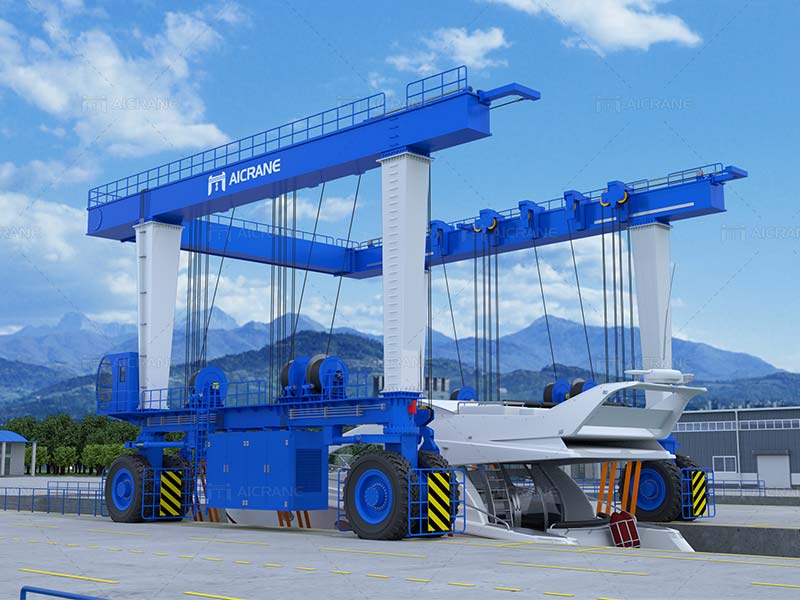Mobile boat travel lifts are essential equipment for the marine industry, providing a convenient and efficient solution for lifting and transporting boats of various sizes. When designing a mobile boat travel lift, several critical factors must be considered to ensure the equipment’s performance, safety, and longevity. This article delves into these design considerations, covering structural integrity, lifting capacity, maneuverability, safety features, and maintenance.

1. Structural Integrity
a. Material Selection: The choice of materials is crucial for the structural integrity of a boat travel lift. Typically, high-strength steel is used for the main frame and support structures due to its durability and ability to withstand heavy loads. Stainless steel or galvanized coatings are often applied to prevent corrosion, especially in the harsh marine environment.
b. Frame Design: The frame design must provide sufficient strength and stability to support the boat’s weight during lifting and transportation. This involves using computational methods to simulate and analyze stress distribution, ensuring that the frame can handle dynamic loads without deformation or failure. Reinforcements and bracing should be strategically placed to enhance the structural rigidity of the lift.
c. Load Distribution: Effective load distribution is essential to prevent uneven stresses on the lift’s components. The design should incorporate features such as adjustable saddles and supports to accommodate various boat sizes and shapes. Proper load distribution also minimizes the risk of tipping or instability during operation.

2. Lifting Capacity and Range
a. Determining Capacity: The lifting capacity of a mobile boat hoist should be determined based on the maximum weight of the boats it will handle. This requires a thorough analysis of the typical boat sizes and weights within the target market. It’s essential to consider not only the maximum weight but also the distribution of the load to ensure safe operation.
b. Lifting Mechanism: The lifting mechanism, often hydraulic or electric, plays a critical role in the performance of the boat lift. Hydraulic systems are commonly used for their smooth and powerful lifting capabilities. The design should include high-quality hydraulic cylinders, pumps, and control valves to ensure reliable and precise lifting.
c. Reach and Height: The lift’s reach and height capabilities should be designed to accommodate the typical boat sizes and the requirements of the marine facility. Adjustable features may be included to handle boats of varying lengths and draft depths. The design must ensure that the lift can comfortably accommodate the largest boats while maintaining stability and safety.
3. Maneuverability and Mobility
a. Wheel and Axle Design: The mobility of the boat travel lift depends on the design of its wheels and axles. Heavy-duty, high-load-bearing wheels are essential for smooth movement and stability. The axles should be designed to withstand the stresses associated with moving heavy loads. Additionally, the wheel configuration must ensure even weight distribution and prevent excessive wear on any single wheel.
b. Steering Mechanism: The steering mechanism of the Aicrane mobile boat travel lift should be designed for ease of maneuverability. Common systems include articulated steering, which allows for precise control in tight spaces, and synchronized steering, which ensures coordinated movement of all wheels. The steering system should be responsive and easy to operate, even under heavy loads.
c. Braking System: An effective braking system is crucial for safe operation. The design should include reliable brakes that can hold the lift stationary during loading and unloading. The braking system should be tested for durability and effectiveness to prevent accidents and ensure operational safety.
4. Safety Features
a. Stability and Anti-Tilt Mechanisms: Safety is paramount in the design of boat handling solution for shipbuilding and maintenance. Stability mechanisms such as outriggers or stabilizing legs should be incorporated to prevent tipping during operation. Anti-tilt sensors and alarms can provide additional safety measures by alerting operators to any potential instability.
b. Safety Controls and Alarms: The control system should include safety features such as emergency stop buttons and overload alarms. These controls allow operators to quickly halt operations in case of an emergency or if the load exceeds the lift’s capacity. Regular maintenance and testing of these safety features are essential to ensure their functionality.
c. Operator Training: Proper operator training is a critical component of safety. The design should include user-friendly controls and clear instructions for operation. Comprehensive training programs should be provided to ensure that operators understand how to use the lift safely and effectively.
5. Maintenance and Durability
a. Ease of Maintenance: The design of the mobile boat travel lift should facilitate easy maintenance and inspections. Components such as hydraulic systems, wheels, and steering mechanisms should be accessible for regular servicing. Design features such as removable panels or maintenance ports can simplify routine checks and repairs.
b. Corrosion Resistance: Given the marine environment, corrosion resistance is a critical consideration. The lift’s components should be coated or treated to resist saltwater and other corrosive elements. Regular inspections for signs of corrosion and timely maintenance can extend the lift’s lifespan.
c. Spare Parts and Support: Availability of spare parts and support services is essential for minimizing downtime. The design should consider the ease of replacing worn or damaged parts, and manufacturers should offer reliable support to address any issues that may arise.
Conclusion
Designing a mobile boat travel lift involves a careful balance of structural integrity, lifting capacity, maneuverability, safety features, and maintenance considerations. By addressing these factors, manufacturers can create equipment that meets the demands of the marine industry, providing efficient and safe solutions for lifting and transporting boats. A well-designed mobile boat travel lift not only enhances operational efficiency but also ensures the safety of both operators and boats.